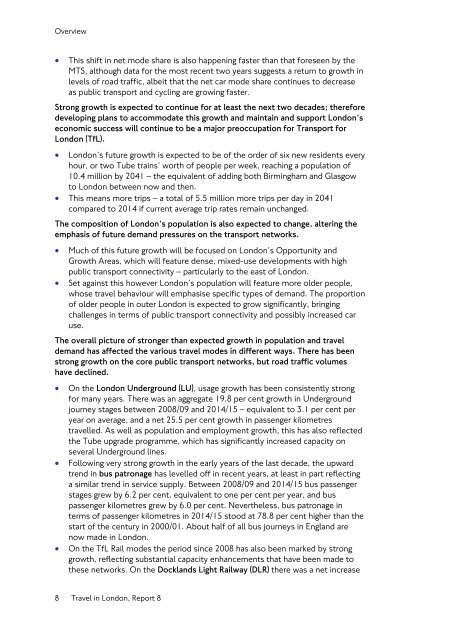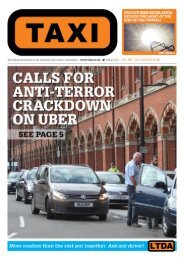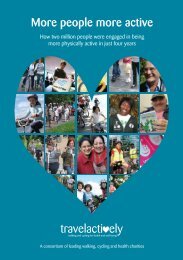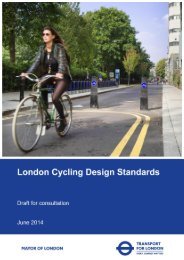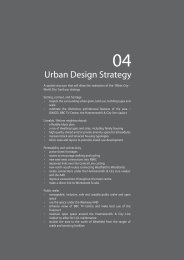Travel in London Travel in London
travel-in-london-report-8
travel-in-london-report-8
You also want an ePaper? Increase the reach of your titles
YUMPU automatically turns print PDFs into web optimized ePapers that Google loves.
Overview<br />
• This shift <strong>in</strong> net mode share is also happen<strong>in</strong>g faster than that foreseen by the<br />
MTS, although data for the most recent two years suggests a return to growth <strong>in</strong><br />
levels of road traffic, albeit that the net car mode share cont<strong>in</strong>ues to decrease<br />
as public transport and cycl<strong>in</strong>g are grow<strong>in</strong>g faster.<br />
Strong growth is expected to cont<strong>in</strong>ue for at least the next two decades; therefore<br />
develop<strong>in</strong>g plans to accommodate this growth and ma<strong>in</strong>ta<strong>in</strong> and support <strong>London</strong>’s<br />
economic success will cont<strong>in</strong>ue to be a major preoccupation for Transport for<br />
<strong>London</strong> (TfL).<br />
• <strong>London</strong>’s future growth is expected to be of the order of six new residents every<br />
hour, or two Tube tra<strong>in</strong>s’ worth of people per week, reach<strong>in</strong>g a population of<br />
10.4 million by 2041 – the equivalent of add<strong>in</strong>g both Birm<strong>in</strong>gham and Glasgow<br />
to <strong>London</strong> between now and then.<br />
• This means more trips – a total of 5.5 million more trips per day <strong>in</strong> 2041<br />
compared to 2014 if current average trip rates rema<strong>in</strong> unchanged.<br />
The composition of <strong>London</strong>’s population is also expected to change, alter<strong>in</strong>g the<br />
emphasis of future demand pressures on the transport networks.<br />
• Much of this future growth will be focused on <strong>London</strong>’s Opportunity and<br />
Growth Areas, which will feature dense, mixed-use developments with high<br />
public transport connectivity – particularly to the east of <strong>London</strong>.<br />
• Set aga<strong>in</strong>st this however <strong>London</strong>’s population will feature more older people,<br />
whose travel behaviour will emphasise specific types of demand. The proportion<br />
of older people <strong>in</strong> outer <strong>London</strong> is expected to grow significantly, br<strong>in</strong>g<strong>in</strong>g<br />
challenges <strong>in</strong> terms of public transport connectivity and possibly <strong>in</strong>creased car<br />
use.<br />
The overall picture of stronger than expected growth <strong>in</strong> population and travel<br />
demand has affected the various travel modes <strong>in</strong> different ways. There has been<br />
strong growth on the core public transport networks, but road traffic volumes<br />
have decl<strong>in</strong>ed.<br />
• On the <strong>London</strong> Underground (LU), usage growth has been consistently strong<br />
for many years. There was an aggregate 19.8 per cent growth <strong>in</strong> Underground<br />
journey stages between 2008/09 and 2014/15 – equivalent to 3.1 per cent per<br />
year on average, and a net 25.5 per cent growth <strong>in</strong> passenger kilometres<br />
travelled. As well as population and employment growth, this has also reflected<br />
the Tube upgrade programme, which has significantly <strong>in</strong>creased capacity on<br />
several Underground l<strong>in</strong>es.<br />
• Follow<strong>in</strong>g very strong growth <strong>in</strong> the early years of the last decade, the upward<br />
trend <strong>in</strong> bus patronage has levelled off <strong>in</strong> recent years, at least <strong>in</strong> part reflect<strong>in</strong>g<br />
a similar trend <strong>in</strong> service supply. Between 2008/09 and 2014/15 bus passenger<br />
stages grew by 6.2 per cent, equivalent to one per cent per year, and bus<br />
passenger kilometres grew by 6.0 per cent. Nevertheless, bus patronage <strong>in</strong><br />
terms of passenger kilometres <strong>in</strong> 2014/15 stood at 78.8 per cent higher than the<br />
start of the century <strong>in</strong> 2000/01. About half of all bus journeys <strong>in</strong> England are<br />
now made <strong>in</strong> <strong>London</strong>.<br />
• On the TfL Rail modes the period s<strong>in</strong>ce 2008 has also been marked by strong<br />
growth, reflect<strong>in</strong>g substantial capacity enhancements that have been made to<br />
these networks. On the Docklands Light Railway (DLR) there was a net <strong>in</strong>crease<br />
8 <strong>Travel</strong> <strong>in</strong> <strong>London</strong>, Report 8


